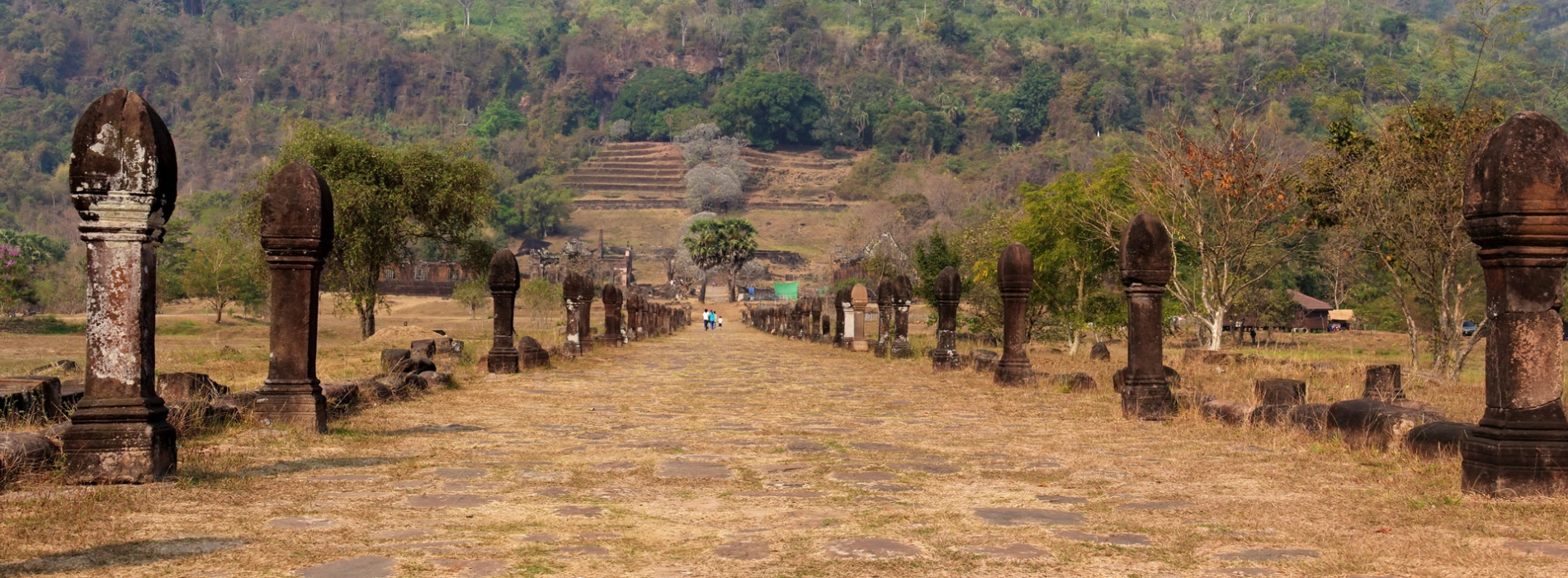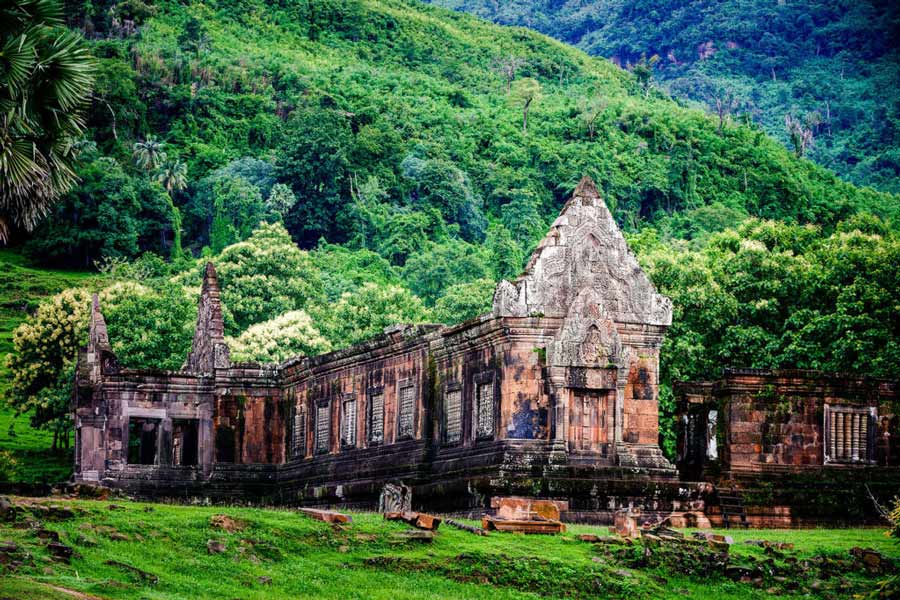Wat Phou

Wat Phou, nestled at the foothills of Mount Phu Kao in the Champasak Province of southern Laos, is an ancient temple complex with a rich history and cultural significance. Over the centuries, it underwent transformations and eventually adopted a Buddhist identity. The architecture bears distinct Khmer influences, reminiscent of the Angkor Wat period, showcasing the empire's reach into Laos. Wat Phou's grandeur is highlighted by imposing structures, terraces, and reservoirs, all thoughtfully integrated with the natural landscape. Recognized as a UNESCO World Heritage Site in 2001, Wat Phou stands as a testament to the historical, architectural, and spiritual legacy of the Khmer Empire in Southeast Asia, inviting visitors to explore its well-preserved ruins and experience the serene ambiance of this cultural gem. Let’s explore Wat Phou with Asia King Travel!
Wat Phou has a rich history that spans over a millennium. The temple's origins can be traced back to the 5th century, making it one of the oldest archaeological sites in Laos. Initially constructed as a Hindu temple dedicated to the god Shiva, Wat Phou was part of the Khmer Empire's expansive influence in the region.

Worship space inside Wat Phou
The Khmer Empire, centered in Cambodia and known for its grand architectural achievements such as Angkor Wat, extended its reach into parts of present-day Laos. Wat Phou, with its strategic location at the base of Mount Phu Kao, became a significant religious and cultural center.
Despite the passage of time, Wat Phou continues to play a role in the religious and cultural life of the region. The site hosts traditional festivals, including the annual Wat Phou Festival, where locals and pilgrims come together to celebrate and pay homage to the temple.

The temple is now a pilgrimage site for Buddhists
In recognition of its historical and cultural importance, Wat Phou was designated as a UNESCO World Heritage Site in 2001. This acknowledgment highlights the temple's role as a testament to the rich history and architectural prowess of the Khmer Empire in Southeast Asia.
Situated facing east, the temple extends along a 1.4km axis, beginning from the plains and ascending to an elevation of 100 degrees above the surrounding terrain. The temple is structurally divided into three distinct areas, corresponding to three ascending steps.
The Lower Temple

Lower Temple area - Path to the Middle Temple area in Wat Phou
The Lower Temple area, or the lowest step, features the Ornamental Entranceway and a sizable lake called Baray (600m x 200m). This space hosts diverse cultural and religious events, including Buddhist and Hindu rituals, animist beliefs, and lively festivals with activities like boat racing and buffalo fighting. Beyond the temple gate is a raised and paved main road (Promenade), bordered by stone columns, leading toward the middle steps. On either side of this road is a lake, formerly a Baray, now partially filled and resembling flat land.
The Middle Temple

Trung Temple area - Ruins of two palaces on both sides of the road
The Middle Temple area includes two Quadrangular Pavilions, the Northern and Southern Palaces, situated on either side of the main axis. These palaces showcase early Angkor Wat architectural style with exquisite sandstone sculptures potentially dating back to the 6th century. Moving along the central axis leads to stairs ascending to the gate for the Upper Temple area. To the south, a small temple honors Nandi, the cow image associated with the Hindu god Shiva, while to the north stands a statue of a guardian god, known as Dvarapala in Khmer.
The Upper Temple

The Upper Temple area
The Upper Temple area, halfway up the mountain, hosts the central temple and the sacred stream. In front of the Thuong Temple is a Gopura Gate with now-destroyed small temples. At the center is the Shiva-Lingam Sanctuary, initially Hindu and later Buddhist, on a 60m x 60m pedestal. It consists of three spaces: a front hall for offerings, a worship hall, and a main hall with an altar. Behind the temple, statues on the cliff venerate the Trimurti—Brahma, Vishnu, and Shiva. Surrounding the main temple are relics, including Buddha's footprints, a crocodile-shaped stone, an elephant-shaped stone, and a Meditation Cella.
Transportation: Once in Laos, local transportation costs, such as buses or taxis, can vary. Budget approximately $5-20 per day for local transport.
Accommodation: Accommodation prices in the vicinity of Wat Phou can range from budget options starting at around $20 per night to mid-range hotels and resorts that may cost between $50 and $150 per night.
Meals: Eating at local restaurants or street food stalls can be relatively affordable in Laos. Plan on budgeting around $10-30 per day for meals, depending on your dining preferences.
Entrance Fees: The entrance fee to Wat Phou was around 50,000 Lao Kip (approximately $5-6 USD). Prices are subject to change, so it's advisable to check current rates
The best time for a visit to Wat Phou in Champasak, Laos, aligns with the dry season, spanning from November to February. During this timeframe, the climate is more agreeable, characterized by cooler temperatures, creating an ideal atmosphere for sightseeing and exploration.
In terms of weather, the cooler and more enjoyable temperatures make it the favored period for experiencing Wat Phou. The landscape flourishes with lush greenery, a result of the previous rainy season, enhancing the overall visual appeal. Additionally, this time coincides with various festivals in Laos, presenting an excellent opportunity to immerse oneself in local cultural celebrations. Overall, the dry season stands out as the most popular choice for a visit to Wat Phou, offering a combination of comfortable weather, vibrant vegetation, and cultural experiences.
By Air: Pakse International Airport is the nearest airport to Wat Phou, located in Pakse, the capital of Champasak Province. You can book flights to Pakse International Airport from Vientiane or other major cities in the region.
By Road: Once you arrive in Pakse, Wat Phou is approximately 40 kilometers (about 25 miles) away. You can hire a taxi, tuk-tuk, or rent a car to reach the temple complex. Buses and shared minivans operate between Pakse and Champasak town. From Champasak town, you can arrange local transportation to Wat Phou.
By Bicycle or Motorbike: If you're an adventurous traveler, you may choose to explore the area around Wat Phou by renting a bicycle or motorbike in Champasak or Pakse